아노말로카리스
"오늘의AI위키"의 AI를 통해 더욱 풍부하고 폭넓은 지식 경험을 누리세요.
1. 개요
아노말로카리스는 캄브리아기 바다에서 살았던 멸종된 절지동물로, 1892년 처음 발견되었다. 머리에는 한 쌍의 겹눈, 입, 부속지가 있으며, 몸통은 유연한 엽으로 구성되어 헤엄치는 데 사용되었다. 아노말로카리스는 전 세계적으로 발견되며, 초기에는 여러 부분으로 잘못 분류되었으나, 이후 재조명을 통해 하나의 생물체였음이 밝혀졌다. 현재 아노말로카리스 속에는 'A. canadensis'와 'A. daleyae' 두 종이 인정되며, 과거 아노말로카리스로 분류되었던 종들은 다른 속으로 재분류되었다.
더 읽어볼만한 페이지
- 라디오돈트목 - 아이기로카시스
아이기로카시스는 오르도비스기 지층에서 발견된 멸종된 해양 절지동물 라디오돈트류의 일종으로, 지느러미와 잎 모양 아가미를 가지고 플랑크톤을 섭식했으며, 캄브리아기 멸종으로 알려진 라디오돈트류가 오르도비스기까지 생존했음을 보여주는 중요한 발견이다. - 라디오돈트목 - 슈카리스
슈카리스는 독특한 전방부속지를 가진 멸종된 방사치류로, 아노말로카리스과 내 초기 분류군이거나 암플렉토벨루아과와 아노말로카리스과를 포함하는 분류군의 자매 분류군으로 추정되며, 작은 구주를 통해 단단한 껍질의 먹잇감을 섭취했을 것으로 보인다. - 1892년 기재된 화석 분류군 - 호모 에렉투스
호모 에렉투스는 약 200만 년 전부터 10만 년 전까지 생존하며 직립 보행을 하고 아슐리안 석기를 제작했으며 불을 사용한 최초의 인류로 추정되는 종이다. - 1892년 기재된 화석 분류군 - 자바 원인
자바 원인은 1891년 인도네시아 자바섬에서 발견된 화석으로, 인류 진화 연구에 중요한 자료이며, 호모 에렉투스로 분류된다. - 캄브리아기의 동물 - 할키에리아류
할키에리아류는 캄브리아기에 살았던 골편으로 덮인 멸종된 동물 분류군으로, 양쪽 끝에 껍데기가 있으며 연체동물, 환형동물, 완족동물 등과의 진화적 관계가 논쟁의 대상이 되고 캄브리아기 보토마절 말 대량 멸종으로 멸종된 것으로 추정된다. - 캄브리아기의 동물 - 오파비니아
오파비니아는 캄브리아기에 살았던 멸종된 해양 절지동물로, 5개의 눈, 코, 지느러미를 가진 몸통과 꼬리를 가지며, 절지동물 줄기군으로 분류되어 캄브리아기 대폭발 연구에 영향을 미쳤다.
| 아노말로카리스 - [생물]에 관한 문서 | |
|---|---|
| 기본 정보 | |
 | |
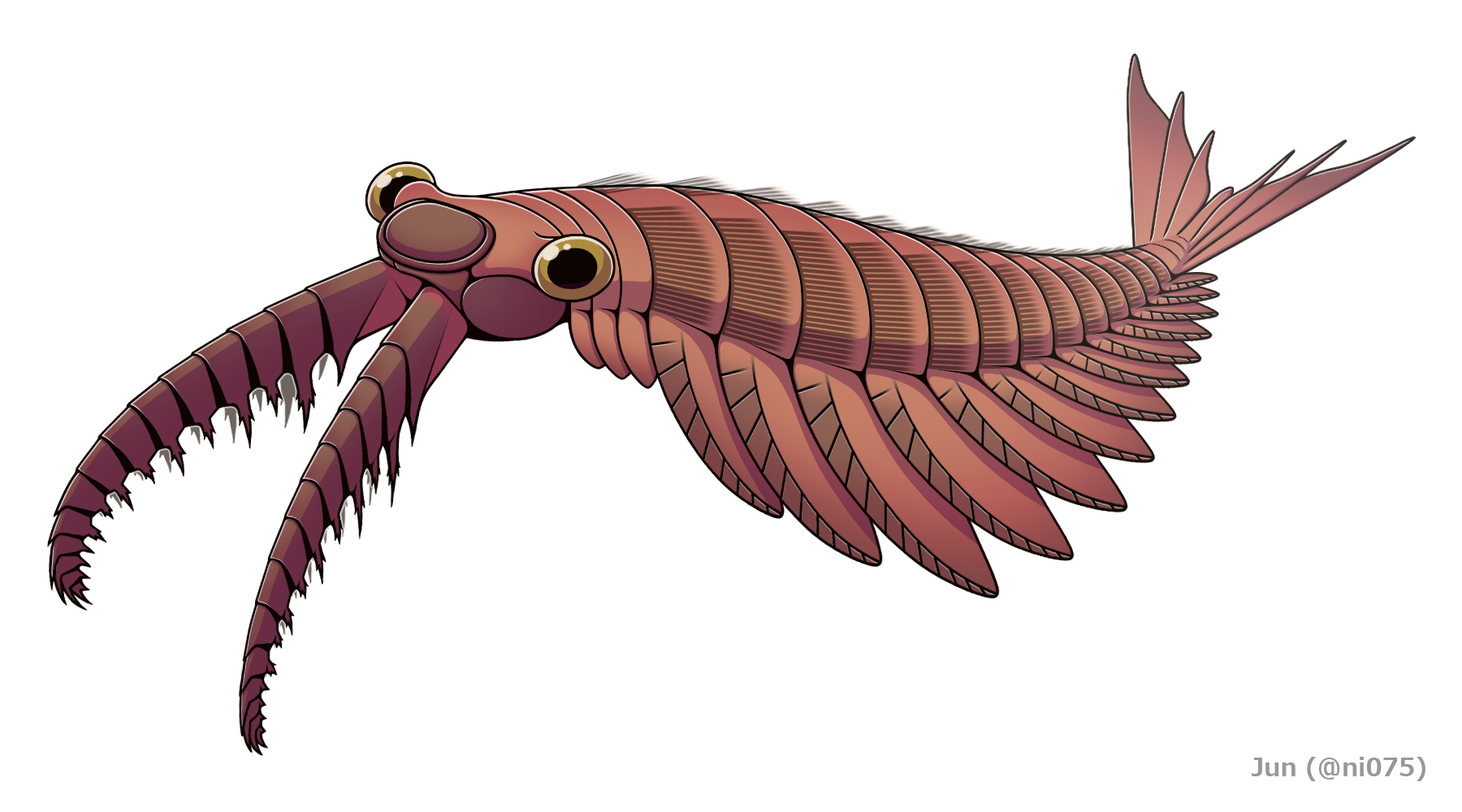 | |
| 화석 발견 시기 | 초기 캄브리아기 - 미들 캄브리아기 (제3절 - 구장기) (약 5억 2천만 년 전 - 4억 9천 9백만 년 전) |
| 학명 | Anomalocaris Whiteaves, 1892 |
| 타입 종 | Anomalocaris canadensis Whiteaves, 1892 |
| 하위 분류 | |
| 종 | Anomalocaris canadensis Whiteaves, 1892 Anomalocaris daleyae Paterson et al., 2023 기타 미명명 종 8개 이상 |
| 생물학적 분류 | |
| 도메인 | 진핵생물 |
| 계 | 동물계 |
| 상문 | 탈피동물 |
| 상문 계급 없음 | 범절지동물 |
| 문 | 절지동물 (스템 그룹) |
| 강 | †공해강(Dinocaridida) |
| 목 | †라디오돈트목(Radiodonta) |
| 과 | †아노마로카리스과(Anomalocarididae) |
| 속 | †아노마로카리스속(Anomalocaris) |
2. 해부 구조
아노말로카리스는 머리, 몸통, 꼬리의 세 부분으로 뚜렷하게 구분되는 독특한 신체 구조를 가지고 있다.
몸통은 세 번째와 다섯 번째 엽 사이에서 가장 넓고 뒤쪽으로 갈수록 좁아지는 형태이며, 최소 11개 이상의 엽(flap)으로 구성되어 있다.[157] 각 엽은 뒷부분이 다른 엽의 아래로 포개지는 형태로 배열되어 있어,[157] 몸 양쪽의 엽들이 마치 하나의 큰 지느러미처럼 기능하여 효율적으로 헤엄칠 수 있게 해준다.[158] 꼬리 부근에서는 엽을 구분하기 어려워 정확한 개수를 세기 힘들다.[157]
각 엽 위쪽에는 아가미로 추정되는 겹겹의 주름(setal blade)이 붙어 있다.[163] 이 주름은 창 모양 잎이라고 알려진 길고 얇은 머리카락 모양의 구조 형태로 배열되어 털 모양의 날을 형성했다. 털 모양의 날은 가장자리가 동물 상단에 부착되어 있었고, 각 몸체 분절당 두 개의 털 모양 날이 있었다. 가운데를 가로지르는 분할선이 아가미를 분리했다.[27]
꼬리는 크고 부채 모양이며, 방향 조절에 사용되었을 것으로 추정된다.[163]
2. 1. 머리
아노말로카리스의 머리에는 한 쌍의 겹눈과 입, 그리고 두 개의 부속지가 달려있다.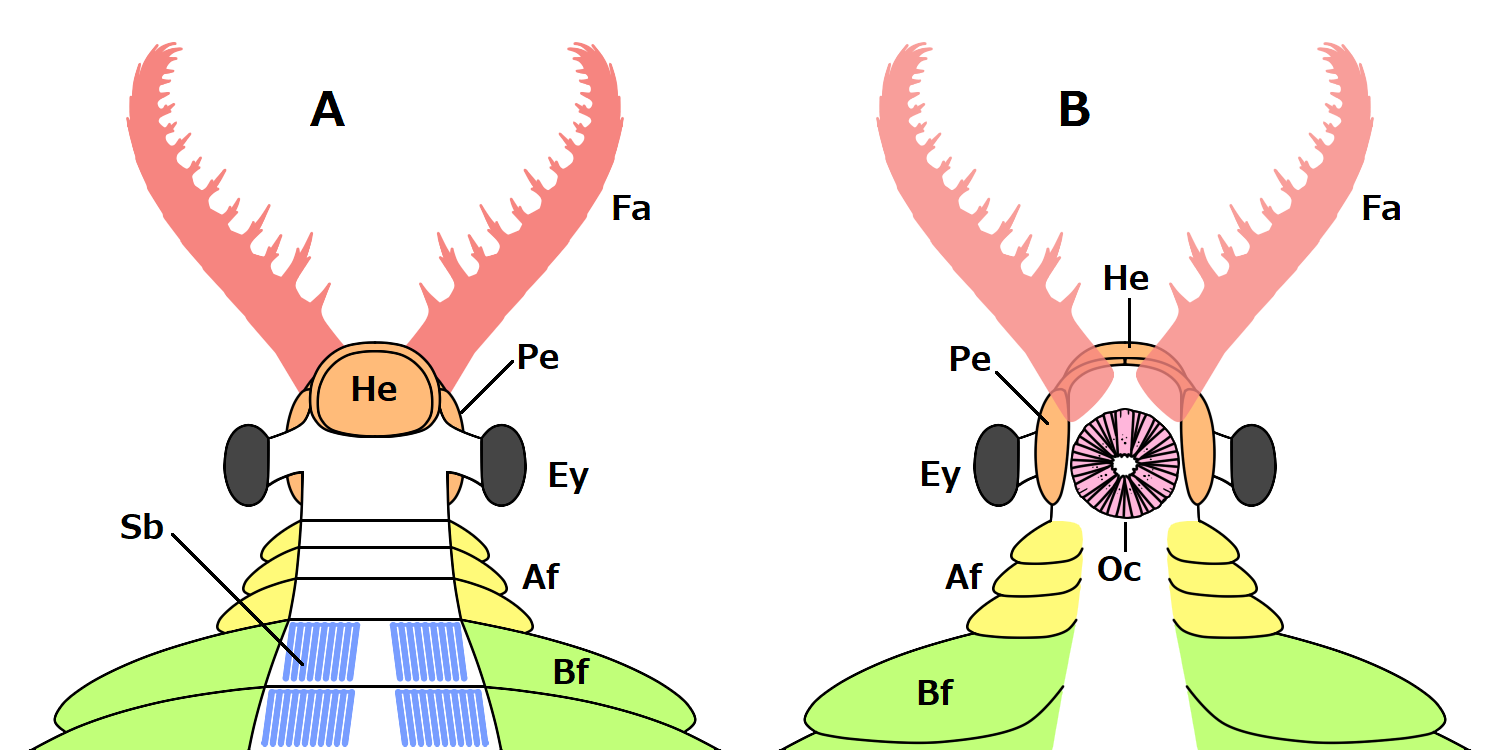
아노말로카리스를 포함한 라디오돈트의 머리에는 중앙에 H 갑각 하나와 양옆에 P 갑각 두 개가 붙어있다.[152] 머리에 달린 두 개의 기다란 촉수처럼 보이는 부속지는 각각 14개의 마디로 나뉘며, 각 마디에는 아래쪽으로 가시가 나 있다. 이 가시 위에는 앞쪽과 뒤쪽으로 또 다른 가시들이 나 있다.[153]
입은 방사형의 구강원뿔(oral cone) 형태이며 삼방사대칭형이다. 구강원뿔은 여러 개의 판이 방사상으로 모여 이루어졌는데, 아노말로카리스는 이 중 세 개의 판이 유달리 크다. 세 개의 큰 판 사이에는 중간 크기의 판이 몇 개 있고, 그 사이에는 작은 판들이 여럿 있어 구강원뿔을 완성한다. 다수의 판 표면에는 오돌토돌한 돌기가 나 있다.[153]
2. 1. 1. 겹눈
2011년에 호주 캥거루섬의 에뮤 베이 셰일에서 캄브리아기(5억 1500만 년 전) 겹눈 화석 여섯 개가 발견되었다.[154][155][156] 이 눈은 아노말로카리스에 속하는 눈으로는 처음 발견된 것으로, 아노말로카리스가 절지동물과 가까운 관계라는 것을 증명해 주었다. 이 발견은 절지동물의 눈이 마디가 있는 다리나 단단한 외골격보다 먼저 진화했다는 것을 보여준다. 이 눈은 삼엽충의 눈보다 30배나 강력하여, 당시 동물 중 가장 발달한 눈을 가졌을 것으로 추정된다. 3 cm 크기의 겹눈은 16,000개 이상의 낱눈으로 구성되어 있었는데,[160][161] 이는 현생 잠자리와 비견될 만한 성능이다.[154][155][156]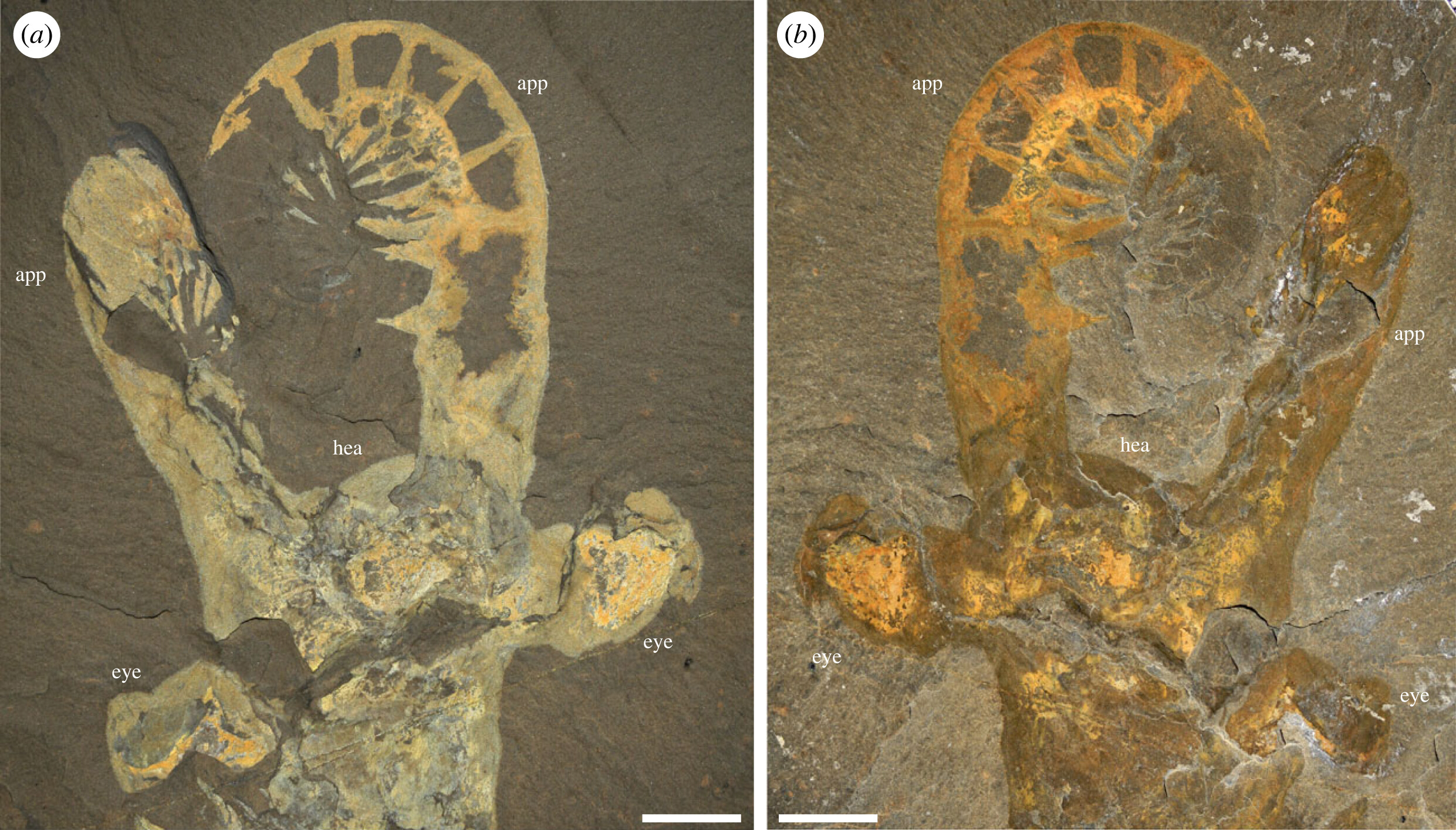
아노말로카리스의 머리는 몸통에 비해 눈에 띄게 작다.[101][67][50] 다른 라디오돈타류와 마찬가지로 정면에는 한 쌍의 앞쪽 부속지, 양쪽 등쪽에는 한 쌍의 겹눈이 있다.[50]
2. 1. 2. 입
아노말로카리스의 입은 '구강원뿔'이라고 불리는 방사형 구조로, 여러 개의 판과 톱니 모양의 돌기로 이루어져 있다.[153] 구강원뿔은 삼방사대칭형이며, 세 개의 큰 판이 특징적이다.[153] 이 세 개의 큰 판 사이에는 중간 크기의 판이 몇 개 있고, 그 사이에는 작은 판들이 여럿 있어 구강원뿔을 완성한다.[153]아노말로카리스의 입은 네 개의 큰 판과 28개의 작은 판이 겹쳐진 파인애플 고리처럼 생겼으며, 중심부에는 톱니 같은 돌기가 튀어나와 있다.[149] 입은 먹잇감을 부수는 데 사용되었지만 완전히 닫히지는 않았고, 톱니 모양의 이빨은 식도 벽까지 이어져 있다.[162]
2. 1. 3. 부속지
아노말로카리스의 머리에 난 두 개의 기다란 촉수처럼 보이는 것은 부속지이다. 하나의 부속지는 14개의 마디로 나뉘고, 각 마디에는 가시가 아래로 나 있다. 가시 위에도 또 다른 가시들이 앞쪽과 뒤쪽으로 나 있다.[153]2. 2. 몸통
아노말로카리스의 몸통은 여러 개의 엽(flap)으로 구성되어 있으며, 최소 11개 이상의 엽을 가지고 있다.[157] 이 엽들은 물결치듯이 움직여 추진력을 얻는 데 사용되었다.[158] 각 엽은 뒷부분이 다른 엽의 아래로 포개지는 형태이며,[157] 이러한 구조는 몸의 양 측면의 엽들이 하나의 큰 지느러미처럼 기능하여 효율적으로 헤엄을 칠 수 있게 해준다.[158] 몸통은 세 번째와 다섯 번째 엽 사이에서 가장 넓으며 뒤쪽으로 갈수록 좁아진다.[157] 꼬리 가까이에서는 엽을 구분하기가 힘들어 정확한 개수를 세기가 어렵다.[157]각 엽 위에는 아가미로 추정되는 겹겹의 주름(setal blade)이 붙어 있다.[163] 이 주름은 창 모양 잎이라고 알려진 길고 얇은 머리카락 모양의 구조 형태로 배열되어 털 모양의 날을 형성했다. 털 모양의 날은 가장자리가 동물 상단에 부착되어 있었고, 각 몸체 분절당 두 개의 털 모양 날이 있었다. 가운데를 가로지르는 분할선이 아가미를 분리했다.[27]
2. 3. 꼬리
꼬리는 크고 부채 모양이며, 최근 연구에서는 방향을 조절하는 데 쓰였을 것으로 보고 있다.[163] 중국에서 발견된 아노말로카리스의 일종으로 여겨지는 표본 ELRC 20001에는 꼬리 끝에 한 쌍의 긴 구조물이 달려 있다.[164]3. 발견
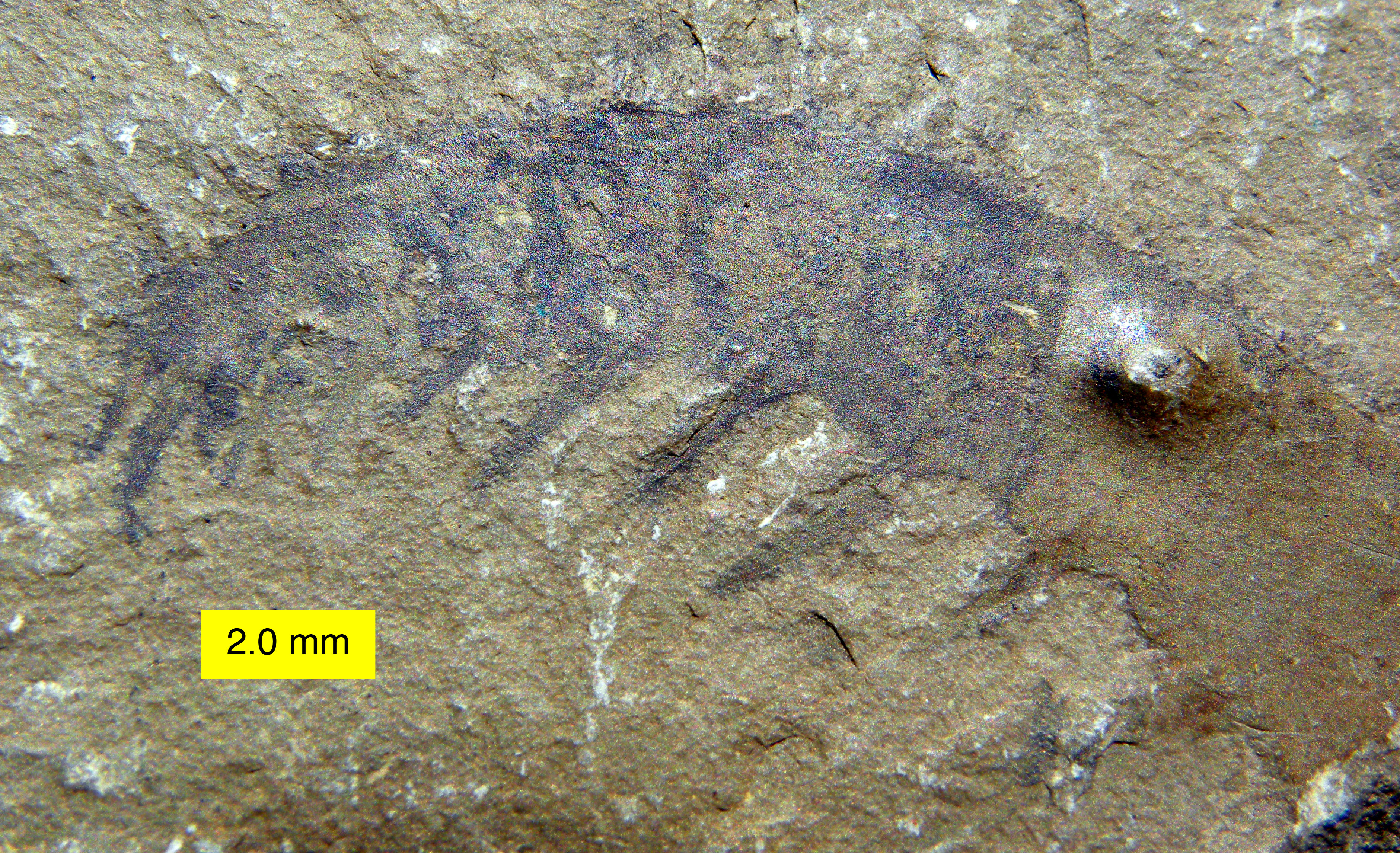
아노말로카리스는 여러 번 잘못 분류되었다. 몸에 광물질화된 부분과 그렇지 않은 부분이 섞여 있었고, 입과 부속지가 다른 부분보다 단단하여 화석화되기 쉬웠기 때문이다.[162] 1892년 조셉 프레데릭 화이트이브스는 따로 발견된 부속지가 멸종한 갑각류와 비슷하다고 보고 '아노말로카리스'라는 이름을 붙였다.[151]
찰스 둘리틀 월컷은 아노말로카리스과의 입 화석을 발견하고 해파리로 오인하여 페이토이아(''Peytoia'')로 분류했다. 월컷은 두 번째 부속지도 발견했지만, 화이트이브스의 발견과 유사성을 인지하지 못하고 멸종한 시드네이아(''Sydneyia'')의 다리나 꼬리로 생각했다.[151] 몸통은 라가니아(''Laggania'')라는 해면동물로 분류되었다.
이후 사이먼 콘웨이 모리스는 몸통과 입이 같이 발견된 화석을 보고, 페이토이아가 라가니아와 우연히 겹쳐진 것으로 해석했다. 그러나 해리 B. 휘팅턴이 암석을 제거하면서 새우 꼬리와 해파리로 여겨졌던 것이 하나로 연결되어 있음을 발견했다.[149][162] 휘팅턴은 두 종을 연결했지만, 페이토이아, 라가니아, 부속지가 모두 거대한 동물 하나라는 것을 깨닫기까지는 몇 년이 더 걸렸다.[151] 페이토이아가 가장 먼저 명명되었기 때문에 전체 동물의 이름이 되었지만, 부속지는 페이토이아 및 라가니아와 구별되는 더 큰 종의 일부였기 때문에 아노말로카리스라는 이름을 유지했다.[153]
스티븐 제이 굴드는 아노말로카리스를 캄브리아기에 다양한 동물 문이 존재했다는 증거로 보았지만,[162] 다른 고생물학자들이 굴드의 결론에 반박하기도 했다.[149]
과거 아노말로카리스속으로 분류되었던 여러 종은 현재 다른 라디오돈트인 것으로 재분류되었다. 사론종(''A. saron'') 및 마그나바시스종(''A. magnabasis'')은 호우카리스(''Houcaris'')로,[165] 펜실바니카종(''A. pennsylvanica'')은 레니시카리스(''Lenisicaris'')로 분류된다.[166] 브릭시종(''A. briggsi'')은 타미시오카리스과(Tamisiocarididae)의 일종으로 여겨지나,[167][168] 아직 재동정 연구는 발표되지 않았다.
현재 아노말로카리스속에서 인정되는 종은 모식종 카나덴시스종(''A.canadensis'')뿐이다. 과거 사론종의 몸통 화석으로 여겨진 표본 ELRC 20001이나 카나덴시스종과 유사한 호주의 아노말로카리스(''A.'' cf. ''canadensis'')도 다른 종일 가능성이 있다.[169]
4. 생태
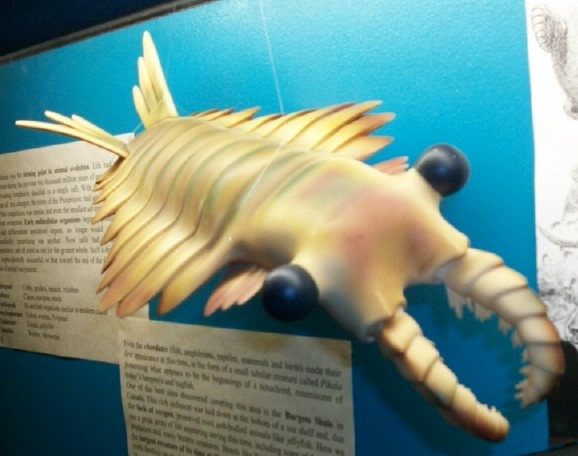
아노말로카리스는 캄브리아기 바다에서 전 세계적으로 분포했으며 캐나다, 중국, 미국, 그리고 호주의 캄브리아기 전기 및 중기 퇴적층에서 화석이 발견된다.[159][170][174][171][166]
아노말로카리스는 삼엽충을 포함하여 단단한 몸을 가진 동물들을 잡아먹고 살았다는 견해가 있었다. 소화기관으로 보면 포식자였던 것으로 생각되지만, 광물질화된 껍질을 부술 수 있었는지는 최근에 회의적인 연구가 많다.[172] 캄브리아기의 삼엽충 중 어떤 것에서는 둥글거나 W 자 모양의 "물린" 자국이 발견되는데, 이것은 아노말로카리스의 입 모양과 일치하는 것으로 생각되었다.[174]
아노말로카리스가 삼엽충을 먹었다는 강력한 증거는 중국에서 발견된 분화석에서 나오는데, 삼엽충 조각이 들어있으며 당시의 동물 중에서는 아노말로카리스과의 동물만이 만들 수 있을 정도로 큰 분화석이 발견되었다.[174] 하지만 아노말로카리스는 광물질로 이루어진 조직을 가지고 있지 않기 때문에 삼엽충의 단단하고 석회질로 이루어진 껍질을 뚫을 수 없었을 수도 있다.[174] 대신 이런 분화석은 다른 동물, 예를 들어 삼엽충에 의해 만들어진 것일 수도 있다.[173]
한 가지 가능성은 아노말로카리스가 먹이의 한쪽 끝을 입으로 물고 부속지로 다른쪽 끝을 빠르게 흔드는 것이다. 이렇게 하면 절지동물 큐티클 층의 약한 부분에 힘이 가해져 외골격이 부서지고 아노말로카리스가 먹이가 되는 동물의 내부에 접근할 수 있게 된다.[174] 이런 행동 때문에 삼엽충이 몸을 동그랗게 마는 방어 행동을 진화시켰을 수도 있다.[174] 하지만 아노말로카리스의 입 부분에 닳은 흔적이 없다는 것은 광물질화된 삼엽충의 외골격과 지속적인 접촉이 없었다는 것을 의미한다. 아노말로카리스의 입 부분을 컴퓨터로 모델링한 결과, 이것이 사실은 작고 부드러운 몸을 가진 동물을 흡입하는 데 더 알맞았으리라는 (그리고 삼엽충의 여러 상처와는 관계가 없으리라는) 결론이 나왔다.[172][175]
5. 분류
아노말로카리스는 라디오돈트목 아노말로카리스과에 속한다. 1892년에 최초로 명명되었고, 1980년대에 처음으로 방사두류로 복원된 속이다.[101]
1990년대에는 아노말로카리스 외에 페이토이아(당시에는 라가니아)와 암플렉토벨루아 등 다른 방사두류의 존재가 알려지면서,[58][54][101] 방사두류(방사두목, 방사치목)에 속하는 것으로 알려지게 되었다.[103]
아노말로카리스는 아노말로카리스과의 모식 속(타입 속)이다. 이 과는 대부분의 계통 분석에서 암플렉토벨루아과와 근연으로 여겨지지만,[103][114][115][49][121][118][108][61] 이빨 구조의 유사성 때문에 타미시오카리스과와 근연으로 여겨지기도 한다.[80]
5. 1. 하위 분류
라디오돈타류 중에서 아노말로카리스속(''Anomalocaris'')으로 분류되는 종은 모식종(타입 종)인 아노말로카리스 카나덴시스(Anomalocaris canadensisla) 외에 몇몇이 있었다.[120] 그러나 20세기부터 2010년대에 걸쳐 본 속은 "아노말로카리스" 브리그시("Anomalocaris" briggsila)나 "아노말로카리스" 사론("Anomalocaris" saronla) 등과 같이 별개의 계통일 가능성이 높은 종을 적지 않게 포함하고 있었다.[120] 계통 분석에서 이들 대부분은 종종 다른 속이나 과에 근연으로 여겨져[103][114][115][49][121][50] 잇달아 본 속에서 제외되어 별도의 속으로 재분류되고 있다.[120][94][122][61][80]5. 1. 1. 과거 아노말로카리스속으로 분류되었던 종
다음은 과거 아노말로카리스속으로 분류되었다가 다른 속으로 재분류된 종들이다.| 종명 | 발견지 | 재분류된 속 | 특징 | 이미지 |
|---|---|---|---|---|
| 레니시카리스·펜실바니카 | 미국 펜실베이니아주 킨저스 층[87] | 레니시카리스[120] | 앞 부속지는 14마디(자루 1마디와 나머지 13마디)로 구성, 내돌기는 단순한 긴 바늘 모양이며 분기되지 않음[128] | -- |
| 에키드나카리스·브릭시 | 오스트레일리아 캥거루 섬 에뮤 베이 셰일[86] | 에키드나카리스[80] | 앞 부속지는 14마디(자루 1마디와 나머지 13마디)로 구성, 내돌기는 동규적이고 가늘며,[60] 자루 이후 대부분의 내돌기는 앞쪽과 뒤쪽 기부에 수많은 분기를 가짐[60], 현탁물 식성을 가졌을 것으로 추정[134][133] | -- |
| 호우카리스·사론 | 중국 윈난성 마오톈산 셰일(청장 동물군)[54] | 호우카리스[94] | 앞 부속지는 가늘고 길며 15마디 이상(자루 2마디 이상과 나머지 13마디)으로 구성, 자루와 그 바로 다음의 다리마디 경계는 위로 굽음[120], 자루 바로 다음의 내돌기는 다소 강대하며 그 이후의 내돌기는 가늘고 대부분 앞쪽으로 5개와 뒤쪽으로 2개의 가는 분기를 가짐[94] | |
| 호우카리스·마그나베시스 | 미국 네바다주 피오체 셰일과 피라미드 셰일[139][138] | 호우카리스[94] | 앞 부속지는 15마디(자루 2마디와 나머지 13마디)로 구성, 기부 3마디는 굵고 자루 끝과 바로 다음의 내돌기는 약간 강대하며 자루 바로 다음의 9개의 내돌기는 각각 앞쪽에 5개와 뒤쪽에 1개의 가는 분기를 가짐[138] | -- |
| 이노바티오카리스·마오톈산넨시스 | 중국 윈난성 마오톈산 셰일(청장 동물군)[58] | 이노바티오카리스[61] | 앞 부속지는 12마디(자루 1마디와 나머지 11마디)로 구성, 전반부의 각각의 내돌기는 앞쪽에만 최대 2개의 분기를 가짐[61] | |
| 슈카리스·앙킬로스켈로스 | 중국 윈난성 마오톈산 셰일(청장 동물군) | 슈카리스[143] | 앞 부속지는 17마디(자루 2마디와 나머지 15마디)로 구성, 자루 바로 다음의 1마디는 2쌍의 내돌기를 가지며 그 이후 제5마디까지의 내돌기는 3쌍의 분기를 가짐[143] |
이 외에도 페이토이아·나토르스티, 암플렉토벨루아·심브라키아타, 람스코르디아·콘시밀리스, 라미나카리스·키메라, 관산카리스·쿤밍겐시스 등이 과거 아노말로카리스속으로 분류되었으나 현재는 다른 속으로 재분류되었다.
참조
[1]
논문
The largest Cambrian animal, ''Anomalocaris'', Burgess Shale, British Columbia
[2]
서적
Wonderful Life: The Burgess Shale and the Nature of History
https://www.worldcat[...]
W.W. Norton
1989
[3]
웹사이트
The Burgess Shale: First Discoveries
https://burgess-shal[...]
Royal Ontario Museum
2023-03-25
[4]
간행물
How the Burgess Shale came to Cambridge; and what happened
https://www.cambridg[...]
Cambridge University Press
1994-09-01
[5]
서적
Catalogue of a Stratigraphical Collection of Canadian Rocks Prepared for the World's Columbian Exposition, Chicago, 1893
https://books.google[...]
Geological Survey of Canada/Government Printing Bureau
1893
[6]
논문
I.—The Canadian Rockies. Part I: On a Collection of Middle Cambrian Fossils obtained by Edward Whymper, Esq., F.R.G.S., from Mount Stephen, British Columbia
https://www.cambridg[...]
1902
[7]
논문
Description of a new genus and species of phyllocarid Crustacea from the Middle Cambrian of Mount Stephen, B.C.
https://books.google[...]
1892
[8]
서적
Wonderful life: the Burgess Shale and the nature of history
W.W. Norton
[9]
서적
The crucible of creation: the Burgess Shale and the rise of animals
Oxford University Press
[10]
논문
A suspension-feeding anomalocarid from the Early Cambrian
http://dro.dur.ac.uk[...]
2014-03
[11]
논문
Brain structure resolves the segmental affinity of anomalocaridid appendages
2014-09
[12]
논문
Anomalocaridid trunk limb homology revealed by a giant filter-feeder with paired flaps
2015-06
[13]
논문
Anomalocaris and other large animals in the lower Cambrian Chengjiang fauna of southwest China
1995-09-01
[14]
논문
Systematics, preservation and biogeography of radiodonts from the southern Great Basin, USA, during the upper Dyeran (Cambrian Series 2, Stage 4)
https://serval.unil.[...]
[15]
논문
''Houcaris'' gen. nov. from the early Cambrian (Stage 3) Chengjiang Lagerstätte expanded the palaeogeographical distribution of tamisiocaridids (Panarthropoda: Radiodonta)
[16]
논문
A large pelagic lobopodian from the Cambrian Pioche Shale of Nevada
https://www.cambridg[...]
2023-12-13
[17]
논문
New anomalocaridids (Panarthropoda: Radiodonta) from the lower Cambrian Chengjiang Lagerstätte: Biostratigraphic and paleobiogeographic implications
[18]
논문
''Innovatiocaris'', a complete radiodont from the early Cambrian Chengjiang Lagerstätte and its implications for the phylogeny of Radiodonta
2022-09-07
[19]
논문
Amplectobeluid Radiodont ''Guanshancaris'' gen. nov. from the Lower Cambrian (Stage 4) Guanshan Lagerstätte of South China: Biostratigraphic and Paleobiogeographic Implications
2023-04
[20]
논문
New suspension-feeding radiodont suggests evolution of microplanktivory in Cambrian macronekton
2018-09
[21]
논문
Origin of raptorial feeding in juvenile euarthropods revealed by a Cambrian radiodontan
2018-11-01
[22]
논문
Exceptional multifunctionality in the feeding apparatus of a mid-Cambrian radiodont
https://zenodo.org/r[...]
2021
[23]
논문
The early Cambrian Emu Bay Shale radiodonts revisited: morphology and systematics
2023-07-10
[24]
논문
The Largest Cambrian Animal, ''Anomalocaris'', Burgess Shale, British Columbia
[25]
논문
Theoretical study on the body form and swimming pattern of Anomalocaris based on hydrodynamic simulation
2006-01
[26]
논문
Giant predators from the Cambrian of China
1994-05
[27]
논문
Morphology of ''Anomalocaris canadensis'' from the Burgess Shale
https://www.academia[...]
2014-01
[28]
논문
A new hurdiid radiodont from the Burgess Shale evinces the exploitation of Cambrian infaunal food sources
2019-08
[29]
논문
Morphology of diverse radiodontan head sclerites from the early Cambrian Chengjiang Lagerstätte, south-west China
https://figshare.com[...]
2018-01-02
[30]
논문
The first discovery of anomalocaridid appendages from the Balang Formation (Cambrian Series 2) in Hunan, China
2013-09-01
[31]
논문
On the Hydrodynamics of Anomalocaris Tail Fins
2018-10
[32]
논문
Acute vision in the giant Cambrian predator Anomalocaris and the origin of compound eyes
https://www.research[...]
2011-12
[33]
논문
Molecular palaeontology illuminates the evolution of ecdysozoan vision
2018-12
[34]
논문
Sophisticated digestive systems in early arthropods
2014-05
[35]
보고서
Reconstructing anomalocaridid feeding appendage dexterity sheds light on radiodontan ecology
2016-12-16
[36]
논문
Three-dimensional modelling, disparity and ecology of the first Cambrian apex predators
2021-07
[37]
간행물
walcott2009
[38]
논문
Raptorial appendages of the Cambrian apex predator Anomalocaris canadensis are built for soft prey and speed
2023-07-12
[39]
논문
"''Anomalocaris'' predation on nonmineralized and mineralized trilobites"
[40]
논문
New anatomical information on ''Anomalocaris'' from the Cambrian Emu Bay Shale of South Australia and a reassessment of its inferred predatory habits
[41]
논문
The oral cone of Anomalocaris is not a classic ''peytoia''
https://www.academia[...]
2012-06
[42]
논문
Arthropod appendages from the Weeks Formation Konservat-Lagerstätte: new occurrences of anomalocaridids in the Cambrian of Utah, USA
http://www.geology.c[...]
2014-05-19
[43]
논문
The Chengjiang Biota inhabited a deltaic environment
2022-03
[44]
문서
The Emu Bay Shale, a Lower Cambrian fossil Lagerstatte, Kangaroo Island, South Australia
https://agris.fao.or[...]
1995
[45]
논문
New anomalocardid frontal appendages from the Guanshan biota, eastern Yunnan
https://www.research[...]
2013-11-01
[46]
웹사이트
Mapping the world's Burgess Shale-type deposits
http://www.virtualmu[...]
2019-09-16
[47]
논문
The endemic radiodonts of the Cambrian Stage 4 Guanshan biota of South China
2021
[48]
논문
The Phylogeny and Evolutionary History of Arthropods
https://www.cell.com[...]
2019-06
[49]
논문
New suspension-feeding radiodont suggests evolution of microplanktivory in Cambrian macronekton
https://www.nature.c[...]
2018-09-14
[50]
논문
A new hurdiid radiodont from the Burgess Shale evinces the exploitation of Cambrian infaunal food sources
https://royalsociety[...]
2019-08-14
[51]
논문
Three-dimensional modelling, disparity and ecology of the first Cambrian apex predators
https://royalsociety[...]
2021-07-28
[52]
논문
Raptorial appendages of the Cambrian apex predator ''Anomalocaris canadensis'' are built for soft prey and speed
https://royalsociety[...]
2023-07-12
[53]
서적
アノマロカリス解体新書
https://www.worldcat[...]
ブックマン社
2020-02-12
[54]
논문
"''Anomalocaris'' and Other Large Animals in the Lower Cambrian Chengjiang Fauna of Southwest China"
https://www.research[...]
1995-09-01
[55]
웹사이트
Anomalocaris canadensis
https://burgess-shal[...]
2023-01-13
[56]
웹사이트
澄江生物群發現多種類奇蝦化石
https://read01.com/A[...]
2020-06-03
[57]
논문
A giant nektobenthic radiodont from the Burgess Shale and the significance of hurdiid carapace diversity
https://royalsociety[...]
2021-09-08
[58]
논문
Evidence for Monophyly and Arthropod Affinity of Cambrian Giant Predators
https://www.academia[...]
[59]
논문
The mouth apparatus of the Cambrian gilled lobopodian ''Pambdelurion whittingtoni''
https://www.research[...]
2016-11
[60]
논문
New anatomical information on ''Anomalocaris'' from the Cambrian Emu Bay Shale of South Australia and a reassessment of its inferred predatory habits
https://onlinelibrar[...]
2013-03
[61]
논문
"''Innovatiocaris'', a complete radiodont from the early Cambrian Chengjiang Lagerstätte and its implications for the phylogeny of Radiodonta"
https://doi.org/10.1[...]
2022-09-07
[62]
논문
The oral cone of ''Anomalocaris'' is not a classic ‘‘peytoia’’
https://www.research[...]
2012-04-05
[63]
논문
The morphology and systematics of the anomalocarid ''Hurdia'' from the Middle Cambrian of British Columbia and Utah
https://www.research[...]
2013-10-01
[64]
논문
A new radiodontan oral cone with a unique combination of anatomical features from the early Cambrian Guanshan Lagerstätte, eastern Yunnan, South China
https://www.cambridg[...]
2018/01
[65]
논문
Acute vision in the giant Cambrian predator Anomalocaris and the origin of compound eyes
https://www.nature.c[...]
2011-12
[66]
논문
Morphology of diverse radiodontan head sclerites from the early Cambrian Chengjiang Lagerstätte, south-west China
https://doi.org/10.1[...]
2017
[67]
논문
Morphology of ''Anomalocaris canadensis'' from the Burgess Shale
https://www.academia[...]
2014-01
[68]
논문
Brain and eyes of ''Kerygmachela'' reveal protocerebral ancestry of the panarthropod head
https://www.nature.c[...]
2018-03-09
[69]
논문
Theoretical study on the body form and swimming pattern of Anomalocaris based on hydrodynamic simulation
http://citeseerx.ist[...]
2005
[70]
논문
On the Hydrodynamics of ''Anomalocaris'' Tail Fins
https://academic.oup[...]
[71]
논문
The diverse radiodont fauna from the Marjum Formation of Utah, USA (Cambrian: Drumian)
https://peerj.com/ar[...]
2021-01-19
[72]
논문
New anomalocaridid appendages from the Burgess Shale, Canada
https://onlinelibrar[...]
2010
[73]
서적
Healed injuries in Ogygopsis klotzi (Trilobita) from the Middle Cambrian of British Columbia
https://catalogue.nl[...]
Royal Ontario Museum
1979
[74]
논문
"Anomalocaris" predation on nonmineralized and mineralized trilobites
https://pubs.geoscie[...]
1999-11-01
[75]
간행물
The Mount Stephen Trilobite Beds
https://www.academia[...]
The Burgess Shale Consortium
2009
[76]
문서
Taking a bite out of Anomalocaris
[77]
논문
Putting Anomalocaris on a soft-food diet?
https://www.research[...]
2010-01-01
[78]
논문
Geochronological constraint on the Cambrian Chengjiang biota, South China
https://www.research[...]
2018-03-15
[79]
논문
The Chengjiang Biota inhabited a deltaic environment
https://www.nature.c[...]
2022-03-23
[80]
논문
The early Cambrian Emu Bay Shale radiodonts revisited: morphology and systematics
https://www.tandfonl[...]
2023-07-10
[81]
논문
Kaili Biota: A Taphonomic Window on Diversification of Metazoans from the Basal Middle Cambrian: Guizhou, China
https://onlinelibrar[...]
2005
[82]
서적
The Kaili Biota: marine organisms from 508 millon years ago
https://www.worldcat[...]
Guizhou Science and Technology Press
2011
[83]
웹사이트
How Old is the Burgess Shale
https://burgess-shal[...]
2023-01-13
[84]
논문
A new Burgess Shale–type assemblage from the “thin” Stephen Formation of the southern Canadian Rockies
https://www.research[...]
2010-09
[85]
논문
The Weeks Formation Konservat–Lagerstätte and the evolutionary transition of Cambrian marine life
https://figshare.com[...]
2018-05-23
[86]
논문
The Emu Bay Shale, a Lower Cambrian fossil Lagerstatte, Kangaroo Island, South Australia
https://agris.fao.or[...]
1995
[87]
문서
New Lower and Middle Cambrian Crustacea
https://repository.s[...]
Proceedings of the United States National Museum
1929
[88]
간행물
"Anomalocaris", the largest known Cambrian arthropod
https://www.palass.o[...]
1979
[89]
논문
A revision of helicoplacoids and other early Cambrian echinoderms of North America
https://repositories[...]
2005
[90]
논문
New sites of Chengjiang fossils: crucial windows on the Cambrian explosion
https://www.research[...]
2001-03
[91]
서적
Early Cambrian Malong Fauna and Guanshan Fauna from Eastern Yunnan,China
https://www.worldcat[...]
Yunnan Science and Techonology Press
2008
[92]
논문
Middle Cambrian arthropods from Utah
https://www.research[...]
2008-03
[93]
논문
Geophysical and geological signatures of relative sea level change in the upper Wheeler Formation, Drum Mountains, West-Central Utah: A perspective into exceptional preservation of fossils
https://www.semantic[...]
2009-06-01
[94]
문서
Houcaris gen. nov. from the early Cambrian (Stage 3) Chengjiang Lagerstätte expanded the palaeogeographical distribution of tamisiocaridids (Panarthropoda: Radiodonta)
https://www.research[...]
2021-03
[95]
논문
Amplectobeluid Radiodont Guanshancaris gen. nov. from the Lower Cambrian (Stage 4) Guanshan Lagerstätte of South China: Biostratigraphic and Paleobiogeographic Implications
https://www.mdpi.com[...]
2023-04
[96]
문서
Description of a new genus and species of phyllocarid Crustacea from the Middle Cambrian of Mount Stephen, B.C.
https://catalog.hath[...]
Canadian Record of Science
1892
[97]
문서
Middle Cambrian holothurians and medusae
https://repository.s[...]
Smithsonian Miscellaneous Collections
1911
[98]
문서
"Laggania cambria Walcott: A Composite Fossil"
https://www.jstor.or[...]
1978
[99]
문서
Critical notes upon some Cambrian arthropods described from Charles D. Walcott
1928
[100]
논문
The largest Cambrian animal, "Anomalocaris", Burgess Shale, British-Columbia
https://royalsociety[...]
1985-05-14
[101]
논문
The “evolution” of Anomalocaris and its classification in the arthropod class Dinocarida (nov.) and order Radiodonta (nov.)
https://www.cambridg[...]
1996/03
[102]
서적
Wonderful life : the Burgess Shale and the nature of history
https://www.worldcat[...]
1989
[103]
논문
A suspension-feeding anomalocarid from the Early Cambrian
https://www.academia[...]
[104]
논문
"Opabinia and Anomalocaris, unique Cambrian ‘arthropods’”
https://onlinelibrar[...]
1986
[105]
논문
A Cambrian gilled lobopod from Greenland
https://www.nature.c[...]
1993-08
[106]
논문
The morphology of ''Opabinia regalis'' and the reconstruction of the arthropod stem-group
https://onlinelibrar[...]
1996-03
[107]
서적
Arthropod Relationships
https://books.google[...]
Springer Science & Business Media
1997-12-31
[108]
논문
New opabiniid diversifies the weirdest wonders of the euarthropod stem group
https://royalsociety[...]
2022-02-09
[109]
논문
Sophisticated digestive systems in early arthropods
https://www.nature.c[...]
2014-05-02
[110]
논문
Origin and evolution of the panarthropod head – A palaeobiological and developmental perspective
https://www.scienced[...]
2017-05-01
[111]
논문
A new ‘great-appendage’ arthropod from the Lower Cambrian of China and homology of chelicerate chelicerae and raptorial antero-ventral appendages
https://onlinelibrar[...]
2004
[112]
논문
A Great-Appendage Arthropod with a Radial Mouth from the Lower Devonian Hunsrück Slate, Germany
https://science.scie[...]
2009-02-06
[113]
논문
The Burgess Shale Anomalocaridid ''Hurdia'' and Its Significance for Early Euarthropod Evolution
https://www.research[...]
2009-03-20
[114]
논문
Brain structure resolves the segmental affinity of anomalocaridid appendages
https://www.research[...]
[115]
논문
Anomalocaridid trunk limb homology revealed by a giant filter-feeder with paired flaps
https://doi.org/10.1[...]
2015-03-11
[116]
논문
Making sense of ‘lower’ and ‘upper’ stem-group Euarthropoda, with comments on the strict use of the name Arthropoda von Siebold, 1848: Upper and lower stem-Euarthropoda
http://eprints.esc.c[...]
2016-02
[117]
논문
An early Cambrian euarthropod with radiodont-like raptorial appendages
https://www.nature.c[...]
2020-12
[118]
논문
Exceptional multifunctionality in the feeding apparatus of a mid-Cambrian radiodont
https://www.cambridg[...]
[119]
논문
A three-eyed radiodont with fossilized neuroanatomy informs the origin of the arthropod head and segmentation
https://www.cell.com[...]
2022-07-08
[120]
논문
New anomalocaridids (Panarthropoda: Radiodonta) from the lower Cambrian Chengjiang Lagerstätte: Biostratigraphic and paleobiogeographic implications
https://www.scienced[...]
2021-03-03
[121]
논문
Origin of raptorial feeding in juvenile euarthropods revealed by a Cambrian radiodontan
https://doi.org/10.1[...]
2018-11-01
[122]
논문
The endemic radiodonts of the Cambrian Stage 4 Guanshan biota of South China
https://app.pan.pl/a[...]
2021
[123]
간행물
Mount Stephen rocks and fossils
https://iris.univ-li[...]
1908-01-01
[124]
간행물
Middle Cambrian Branchiopoda, Malacostraca, Trilobita and Merostomata
https://repository.s[...]
1912-01-01
[125]
논문
The first discovery of anomalocaridid appendages from the Balang Formation (Cambrian Series 2) in Hunan, China
https://www.research[...]
2013-09
[126]
논문
Arthropod appendages from the Weeks Formation Konservat-Lagerstätte: new occurrences of anomalocaridids in the Cambrian of Utah, USA
https://www.research[...]
2014-05-19
[127]
논문
Hurdiid radiodontans from the middle Cambrian (Series 3) of Utah
https://www.cambridg[...]
2018-01
[128]
논문
The Kinzers Formation (Pennsylvania, USA): the most diverse assemblage of Cambrian Stage 4 radiodonts
https://www.cambridg[...]
2019-07
[129]
논문
The lower Cambrian KIN Fauna of Chengjiang Fossil Lagerstätte from Yunnan, China
1992-01-01
[130]
논문
Lower Cambrian Burgess Shale-type fossil associations of South China
https://www.scienced[...]
2005-05-02
[131]
논문
A large pelagic lobopodian from the Cambrian Pioche Shale of Nevada
https://www.cambridg[...]
2023-12-13
[132]
논문
Rapid growth in a large Cambrian apex predator
https://doi.org/10.1[...]
2023-11-03
[133]
논문
Disparate compound eyes of Cambrian radiodonts reveal their developmental growth mode and diverse visual ecology
https://advances.sci[...]
2020-12-01
[134]
논문
Reconstructing anomalocaridid feeding appendage dexterity sheds light on radiodontan ecology
https://www.research[...]
2016-12-16
[135]
논문
The arthropods of the Lower Cambrian Chengjiang fauna, with relationships and evolutionary significance
1991-01-01
[136]
서적
Early Cambrian Chengjiang fauna from Kunming Region, China
https://www.worldcat[...]
Yunnan Science & Technology Press
[137]
논문
New radiodonts with gnathobase-like structures from the Cambrian Chengjiang biota and implications for the systematics of Radiodonta
https://onlinelibrar[...]
2018-06-23
[138]
논문
Systematics, preservation and biogeography of radiodonts from the southern Great Basin, USA, during the upper Dyeran (Cambrian Series 2, Stage 4)
https://onlinelibrar[...]
[139]
논문
A NEW SOFT-BODIED FAUNA: THE PIOCHE FORMATION OF NEVADA
https://bioone.org/j[...]
2003-07
[140]
논문
A new radiodont (stem Euarthropoda) frontal appendage with a mosaic of characters from the Cambrian (Series 2 Stage 3) Chengjiang biota
http://doi.wiley.com[...]
2018
[141]
논문
The Cambrian Fossils of Chengjiang, China
https://doi.org/10.1[...]
2003-12-19
[142]
논문
New anomalocardid frontal appendages from the Guanshan biota, eastern Yunnan
https://www.research[...]
2013-11
[143]
논문
A new radiodont from the lower Cambrian (Series 2 Stage 3) Chengjiang Lagerstätte, South China informs the evolution of feeding structures in radiodonts
https://www.tandfonl[...]
2024-12-31
[144]
서적
Some Silurian (Ontarian) Faunas of New York
https://books.google[...]
University of the state of New York
1925
[145]
논문
Lower Cambrian Olenellus zone of the Appalachians
https://pubs.geoscie[...]
1938-02-01
[146]
논문
A New Trilobite-like Arthropod from the Lower Cambrian Kinzers Formation, Pennsylvania
https://www.jstor.or[...]
1978
[147]
웹사이트
JPL Small-Body Database Browser
https://ssd.jpl.nasa[...]
2021-05-31
[148]
웹사이트
Asteroid (8564) Anomalocaris
https://rasc.ca/aste[...]
2021-05-31
[149]
서적
The crucible of creation: the Burgess Shale and the rise of animals
Oxford University Press
[150]
저널
The largest Cambrian animal, Anomalocaris, Burgess Shale, British Columbia
[151]
저널
New suspension-feeding radiodont suggests evolution of microplanktivory in Cambrian macronekton
http://www.nature.co[...]
[152]
저널
A new hurdiid radiodont from the Burgess Shale evinces the exploitation of Cambrian infaunal food sources
https://royalsociety[...]
[153]
저널
The oral cone of Anomalocaris is not a classic ‘‘peytoia’’
http://link.springer[...]
[154]
뉴스
Ancient discovery puts world's scientific eyes on Kangaroo Island
http://www.abc.net.a[...]
ABC News (Australia)
2011-06-30
[155]
웹인용
Cambrian predator had killer eyes
http://www.abc.net.a[...]
ABC Science
2011-12-08
[156]
간행물
Fossilised eyes of ancient super-predator found
http://www.australia[...]
Australian Geographic
2011-12-09
[157]
저널
The Largest Cambrian Animal, Anomalocaris, Burgess Shale, British Columbia
[158]
저널
Theoretical study on the body form and swimming pattern of Anomalocaris based on hydrodynamic simulation
[159]
저널
Giant Predators from the Cambrian of China
[160]
저널
Acute vision in the giant Cambrian predator Anomalocaris and the origin of compound eyes
[161]
뉴스
Ancient super-predator eyes found in Australia
http://au.news.yahoo[...]
Seven News
2011-12-11
[162]
서적
Wonderful life: the Burgess Shale and the nature of history
W.W. Norton
[163]
저널
On the Hydrodynamics of Anomalocaris Tail Fins
https://academic.oup[...]
[164]
저널
Evidence for Monophyly and Arthropod Affinity of Cambrian Giant Predators
https://www.science.[...]
[165]
저널
Houcaris gen. nov. from the early Cambrian (Stage 3) Chengjiang Lagerstätte expanded the palaeogeographical distribution of tamisiocaridids (Panarthropoda: Radiodonta)
https://link.springe[...]
[166]
저널
New anomalocaridids (Panarthropoda: Radiodonta) from the lower Cambrian Chengjiang Lagerstätte: Biostratigraphic and paleobiogeographic implications
https://linkinghub.e[...]
[167]
저널
A suspension-feeding anomalocarid from the Early Cambrian
http://www.nature.co[...]
[168]
저널
A new hurdiid radiodont from the Burgess Shale evinces the exploitation of Cambrian infaunal food sources
https://royalsociety[...]
[169]
저널
New anomalocaridids (Panarthropoda: Radiodonta) from the lower Cambrian Chengjiang Lagerstätte: Biostratigraphic and paleobiogeographic implications
https://www.scienced[...]
[170]
저널
The Occurrence of the Giant Arthropod Anomalocaris in the Lower Cambrian of Southern California, and the Overall Distribution of the Genus
http://jpaleontol.ge[...]
[171]
저널
Exceptionally preserved nontrilobite arthropods and Anomalocaris from the Middle Cambrian of Utah
http://hdl.handle.ne[...]
[172]
walcott2009
[173]
저널
New anatomical information on Anomalocaris from the Cambrian Emu Bay Shale of South Australia and a reassessment of its inferred predatory habits
[174]
저널
Anomalocaris predation on nonmineralized and mineralized trilobites
[175]
뉴스
Fossil fangs not so fierce
http://sciencenews.o[...]
Science News
2010-11-11
본 사이트는 AI가 위키백과와 뉴스 기사,정부 간행물,학술 논문등을 바탕으로 정보를 가공하여 제공하는 백과사전형 서비스입니다.
모든 문서는 AI에 의해 자동 생성되며, CC BY-SA 4.0 라이선스에 따라 이용할 수 있습니다.
하지만, 위키백과나 뉴스 기사 자체에 오류, 부정확한 정보, 또는 가짜 뉴스가 포함될 수 있으며, AI는 이러한 내용을 완벽하게 걸러내지 못할 수 있습니다.
따라서 제공되는 정보에 일부 오류나 편향이 있을 수 있으므로, 중요한 정보는 반드시 다른 출처를 통해 교차 검증하시기 바랍니다.
문의하기 : help@durumis.com